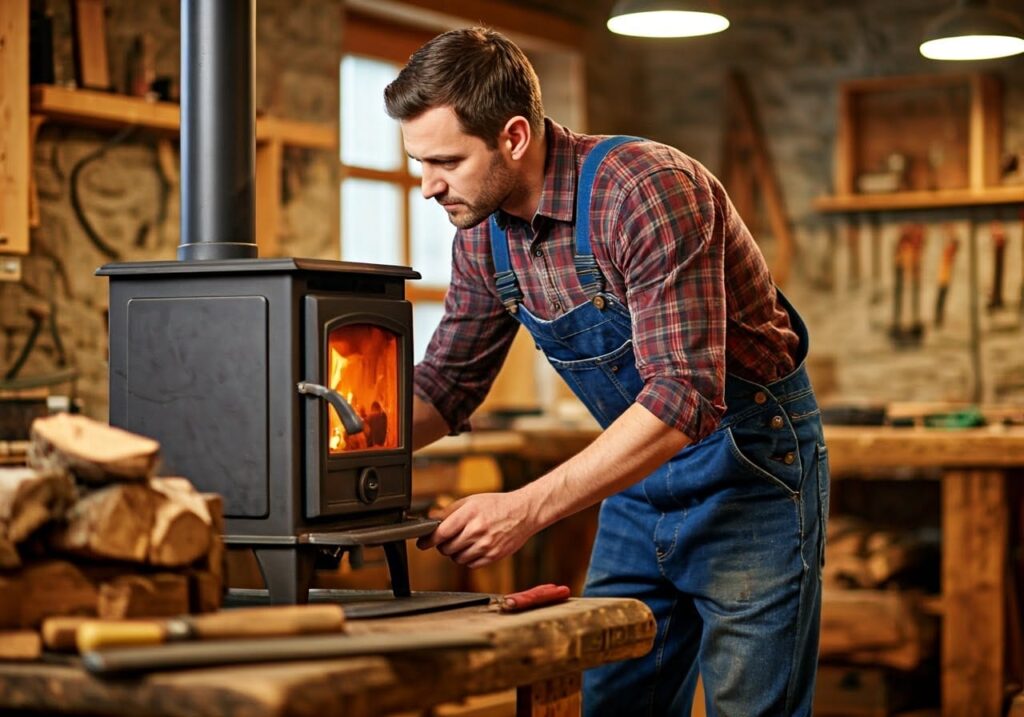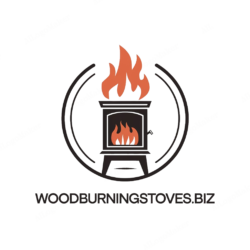Owning a wood-burning stove brings warmth, comfort, and even a touch of rustic charm to your home. But keeping that stove efficient and safe isn’t just about lighting a fire and enjoying the heat—it’s about regular upkeep and specific safety practices. Here’s a comprehensive guide on Wood Burning Stove maintenance, best practices, and added safety recommendations to keep your stove functioning well and your household protected.

- Listen to our Podcast on Maintenance and Security
- Why Regular Maintenance is Crucial
- Choosing the Right Wood
- Chimney and Flue Cleaning
- Essential Safety Features
- Efficient Burning Practices
- Additional Safety Recommendations
- Long-Term Maintenance Tips
- Common Mistakes to Avoid
- Our Tool for Maintenance Checks
- Final Words: Do NOT Forget your Wood Burning Stove Maintenance
Listen to our Podcast on Maintenance and Security
Why Regular Maintenance is Crucial
With wood stoves, maintenance is essential, not just an occasional chore. Regular upkeep prevents costly repairs, improves efficiency, and significantly reduces fire risks. Here’s a breakdown of how to keep your stove in top shape:
- Weekly Interior Cleaning
Removing ash weekly is a small but essential maintenance task to maintain proper airflow and prevent overheating. Start with a shovel to clear out large ash deposits from the firebox, then finish up with a wire brush for soot and stubborn deposits. Regularly clearing out ash helps keep your stove running safely and efficiently. - Annual Professional Inspection
Every year, a certified professional should inspect your stove, including the chimney, firebricks, gaskets, and glass. Professionals help identify creosote buildup—a highly flammable byproduct of burning wood. Catching wear and tear early prevents small issues from becoming big risks down the line. - Check Door Seals and Gaskets
The door gasket (often a rope seal) should be tight enough to prevent air leaks that can lead to inefficient burns. Replacing worn gaskets ensures the stove burns properly, maximizing efficiency and keeping any dangerous fumes out of your home.
Choosing the Right Wood
The type of wood you burn can make all the difference in performance and safety. Choosing seasoned hardwoods not only increases burn efficiency but reduces creosote deposits in the chimney, decreasing fire risks.
- Avoid Green Wood
Freshly cut wood has high moisture content, which produces more smoke, creosote, and soot—bad for both your chimney and indoor air quality. Aim for wood that has been dried for at least a year, with a moisture content under 25%. - Choose Hardwoods Over Softwoods
Hardwoods like oak, hickory, and maple burn slower and hotter, making them ideal for stoves. Softwoods burn faster and don’t provide the long, steady heat that hardwoods offer, but they’re great for kindling.
Chimney and Flue Cleaning
A clean chimney is vital for safety, as creosote buildup can ignite and cause dangerous chimney fires. Here’s what you need to know about keeping your chimney and flue clean:
- Routine Sweeping
At minimum, sweep the chimney annually. Heavy stove users might consider sweeping twice a year, particularly if your stove is used daily in the winter. Use a chimney brush to reach all areas, focusing especially on any horizontal sections where creosote tends to accumulate more quickly. - Professional Assistance
For complex chimneys or insulated stovepipes, it’s wise to call a certified professional. They have the tools and expertise to clean all areas effectively, especially if your chimney has bends or difficult-to-reach spots.
Essential Safety Features
Whether you’re a new stove owner or have had one for years, having these safety features is non-negotiable to ensure you’re prepared for any situation.
- Carbon Monoxide and Smoke Detectors
Detectors should be installed in any room with a stove, and test them monthly to ensure they’re in working order. Carbon monoxide is a silent, invisible risk with wood stoves, making detectors essential for safety. You can purchase them here. - Fire Extinguisher
Place a fire extinguisher rated for wood fires nearby but not so close that it would be hard to access in a fire emergency. Having one on hand helps contain any potential fire-related incidents that might arise. - Heat Shields and Proper Clearances
Install heat shields on walls near the stove, particularly if it’s close to a wall. Keeping furniture and other combustibles away from the stove—at least three feet, in most cases—reduces fire risks. Proper clearance around the stove helps maintain a safe setup.
Efficient Burning Practices
Burning efficiently is all about maximizing heat while minimizing smoke and creosote production. Use these tips to keep your fire burning cleanly and safely.
- Small, Hot Fires
Building smaller fires that burn hotter is more efficient than letting a large fire smolder. Smaller, hotter fires burn more completely and help prevent creosote buildup. Start with a base of kindling, gradually adding larger logs as the fire intensifies. - Avoid Liquid Fire Starters
Gasoline, lighter fluid, and other accelerants are dangerous in wood stoves. They can release toxic fumes and increase the risk of stove damage and accidental fire. Stick with dry kindling or firelighters designed specifically for wood stoves. - Use Airwash Systems
Many modern stoves feature an airwash system that directs airflow across the stove glass, keeping it clean. Airwash keeps soot off the glass and makes it easier to monitor the fire, which is crucial for safety and efficiency.
Additional Safety Recommendations
Here are some additional safety steps you can take to protect both your home and your wood stove:
- Stovepipe and Ventilation Checks
Monthly inspections of the stovepipe and ventilation system can catch small issues before they become big problems. Look for signs of wear, cracks, or leaks. Ensuring proper airflow prevents backdrafting and carbon monoxide risks. - Wood Storage Proximity
Keep all firewood at least three feet away from the stove to prevent accidental ignitions from stray sparks. Store larger wood supplies outside and bring in only what you plan to burn within the next day or so. - Safe Ash Disposal
Always wait until ashes have cooled, then transfer them to a non-combustible metal container with a lid. Store the container outside, away from any structures. Hot ashes can smolder for hours, so never dispose of them in plastic or paper containers. - Hearth Pad or Floor Protection
Place a non-combustible hearth pad underneath the stove to protect your flooring from heat, stray embers, and ash. A heat-resistant pad also helps absorb the wear and tear from the stove, extending your floor’s lifespan. - Follow Local Fire Codes
Different areas may have specific codes for wood stove installation, clearances, and chimney configurations. These codes are designed for safety, so be sure to check with local authorities to ensure your setup meets all guidelines. - Have a Fire Escape Plan
Prepare a fire escape plan for everyone in the home, including clear exit routes and practice these regularly. Make sure all household members know where the fire extinguisher is located and how to use it effectively. - Install a Heat Shield
If space around your stove is tight, install a heat shield to protect walls from prolonged exposure to high heat. Heat shields reduce the risk of accidental fires and add an extra layer of security.
Long-Term Maintenance Tips
Keeping your stove well-maintained over time extends its life and ensures you’re getting the most out of your heating source.
- Replace Worn Components
Keep an eye on the stove’s firebricks, gaskets, and glass. Replace any worn or damaged components to maintain airtightness and efficiency. Damaged parts can lead to inefficiencies or safety hazards if left unchecked. - Clean the Glass Regularly
A clean glass panel doesn’t just look good—it improves heat output and lets you keep an eye on the fire’s intensity. Clean with a specialized stove glass cleaner only when the stove is cool, and avoid abrasive tools to prevent scratching. - Proper Firewood Storage
Store wood outdoors in a dry place, protected from the elements. Seasoned, well-dried wood keeps creosote buildup to a minimum, burns more efficiently, and reduces maintenance needs.
Common Mistakes to Avoid
Avoid these common pitfalls to get the best performance from your stove and ensure safety:
- Overloading the Firebox
More wood doesn’t equal more heat. Overloading restricts airflow, causing incomplete combustion and an excess of smoke and creosote. Stick to a manageable load and keep airflow unrestricted. - Burning Non-Wood Materials
Treated wood, painted scraps, or other non-wood materials release harmful chemicals and can damage your stove. Stick with natural, untreated wood only. - Ignoring Draft Issues
If smoke backs up into the room, this is often a draft issue or a sign of blockage. Address it immediately to prevent health hazards and keep your stove running smoothly.
Our Tool for Maintenance Checks
Wood Burning Stove Maintenance Guide
Important Safety Reminders
- Always dispose of ashes in a metal container with a tight lid
- Store firewood away from the house and keep it covered
- Keep a fire extinguisher rated for wood fires nearby
Final Words: Do NOT Forget your Wood Burning Stove Maintenance
A well-maintained wood-burning stove brings warmth, ambiance, and efficiency to your home. By sticking to these maintenance tips and safety guidelines, you can enjoy the comfort of your stove without worry. Prioritize regular upkeep, commit to safe burning practices, and keep essential safety features on hand to ensure you’re always operating in a secure environment.
